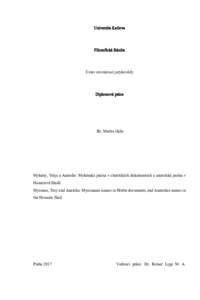Mycenae, Troy and Anatolia: Mycenaean names in Hittite documents, and Anatolian names in the Homeric Iliad
Mycenae, Troy and Anatolia: Mycenaean names in Hittite documents, and Anatolian names in the Homeric Iliad
diplomová práce (OBHÁJENO)

Zobrazit/
Trvalý odkaz
http://hdl.handle.net/20.500.11956/92943Identifikátory
SIS: 167347
Katalog UK: 990021600360106986
Kolekce
- Kvalifikační práce [24991]
Autor
Vedoucí práce
Konzultant práce
Pavúk, Peter
Oponent práce
Bakyta, Ján
Fakulta / součást
Filozofická fakulta
Obor
Srovnávací jazykověda
Katedra / ústav / klinika
Ústav srovnávací jazykovědy
Datum obhajoby
15. 9. 2017
Nakladatel
Univerzita Karlova, Filozofická fakultaJazyk
Angličtina
Známka
Velmi dobře
Klíčová slova (česky)
Anatolie|Trója|Homér|Atroponyma|Toponyma|etnonyma|vypůjčky|kontakt|Iliada|mykénština|chetitština|luwijštinaKlíčová slova (anglicky)
Anatolia|Troia|Homer|Anthroponyms|Toponyms|Borrowing|Language Contact|Ethnonyms|Iliad|Mycenaean|Hittite|Luwian(česky): Cílem stávající práce je poskytnout aktuální souhrn podložený historickými fakty a textovým svědectvím z primárních zdrojů, který by podal koherentní popis dlouho diskutované otázky vzájemných vztahů mezi Chetity (resp. Anatolií) a Řeckým světem především v době pozdně bronzové. Za tímto účelem byla sesbírána data z různých vědeckých odvětví. Po krátkém úvodu do onomastiky a do historie řecko-anatolských studií následuje hlavní část práce sestávající z rozboru antroponym a toponym v těchto jazycích jak ze synchronního, tak i diachronního pohledu.
(in English): The aim of the present work is to offer an up-to-date synopsis based on historical data and textual evidence that would give a coherent description of the long-discussed question of the mutual relations between the Hittite (or Anatolian) and the Greek world in the period of the Late Bronze Age. In order to do so, various data from different scientific fields were put together. After a brief introduction to onomastics and the history of the Greco-Anatolian studies follows the main part of the work which deals with probably mutually borrowed anthropo- and toponyms in these languages from both a diachronic and synchronic point of view.
